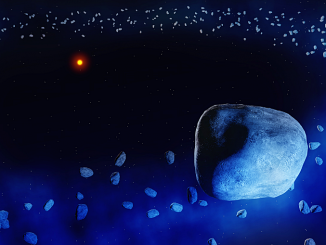
Search Results for asteroids


Clues to ancient 15-mile-wide asteroid impact found in Western Australia
An international team of scientists has found evidence of a major asteroid impact that occurred approximately 3.5 billion years ago. Tiny glass beads called spherules formed from vaporised material from the asteroid impact were found in a drill core from Australia in some of the oldest known sediments on Earth.

Kepler-223 star system has four mini-Neptunes in synchronised orbits
A four-planet system orbiting the star Kepler-223 in the constellation Cygnus is actually a rarity: Its planets, all miniature Neptunes nestled close to the star, are orbiting in a unique resonance that has been locked in for billions of years. For every three orbits of the outermost planet, the second orbits four times, the third six times and the innermost eight times.

2007 OR10: the largest unnamed world in the solar system
By combining data from two space observatories, astronomers have revealed something surprising: a 955-mile-wide dwarf planet named 2007 OR10 is significantly larger than previously thought. Although its 547-year-long elliptical orbit brings it nearly as close to the Sun as Neptune, 2007 OR10 is currently twice as far from the Sun as Pluto.

Pluto’s interactions with the solar wind are unique
Using data gathered by NASA’s New Horizons spacecraft on its Pluto flyby in July 2015, the dwarf planet has some characteristics less like that of a comet and more like much larger planets, according to the first analysis of Pluto’s unique interaction with the solar wind — the charged particles that spew off from the Sun into the solar system at a supersonic 1 million mph.

A piece of the early solar system returns after billions of years in cold storage
Astronomers have found a unique object that appears to be made of material from the time of Earth’s formation, which has been preserved in the Oort Cloud for billions of years. C/2014 S3 (PANSTARRS) is the first object to be discovered on a long-period cometary orbit that has the characteristics of a pristine inner solar system asteroid.

Early Mars bombardment likely enhanced its habitability
Much of the action on Mars occurred during a period known as the Late Heavy Bombardment about 3.9 billion years ago. Large comets and asteroids raining down on the planet would have produced enough heat to melt subsurface ice, likely enhancing climate conditions enough to make Mars more conducive to life — at least for a time.

Global Astronomy Month begins 1 April
Global Astronomy Month (GAM), organised each April by Astronomers Without Borders, is the world’s largest annual global celebration of astronomy. Each GAM brings new ideas and new opportunities, and GAM 2016 is no exception, once again bringing enthusiasts together worldwide to celebrate Astronomers Without Borders’ motto: One People, One Sky.

ExoMars spotted in space en route to Red Planet
On 14 March, the ExoMars spacecraft and Schiaparelli lander were lofted into orbit by a Proton rocket, starting a seven-month journey to the Red Planet. For the ExoMars launch, ESA’s near-Earth object (NEO) coordination centre in Italy organised a successful international campaign for ground-based optical observations of the departing spacecraft.

Unexpected changes of bright spots on Ceres discovered
New and very precise observations using the HARPS spectrograph with the ESO 3.6-metre telescope in Chile have not only detected the motion of the enigmatic bright spots on Ceres due to the dwarf planet’s rotation about its axis, but also found unexpected additional variations suggesting that the material of the spots is volatile and evaporates in sunlight.
